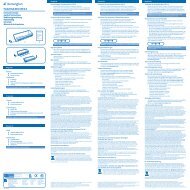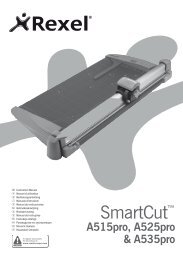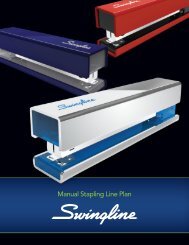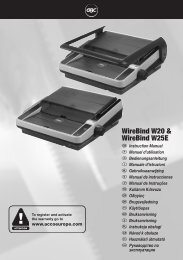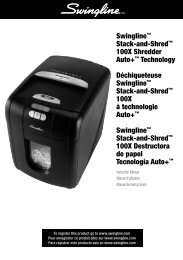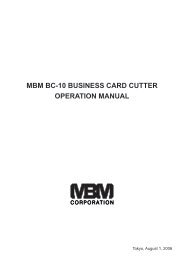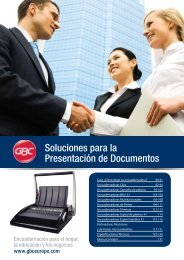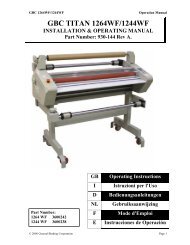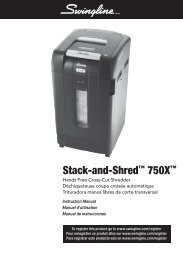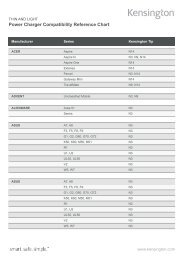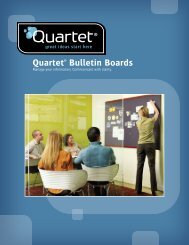GBC Catena cover - Net
GBC Catena cover - Net
GBC Catena cover - Net
- No tags were found...
You also want an ePaper? Increase the reach of your titles
YUMPU automatically turns print PDFs into web optimized ePapers that Google loves.
IDSPEED/TEMPERATURE GUIDE AND THE ARTOF LAMINATIONDo not attempt to laminate abrasive ormetal objects such as staples, paper clipsand glitter, as they may damage the heator pull rollers.Do not force items into the nip area of theheat rollers. An item that is not easilydrawn into the laminator by the heatrollers is probably too thick to laminate.Wrinkles may result if an attempt is madeto reposition an item once it has beengrasped by the heat rollers.Do not stop the laminator before an itemhas completely exited the pull rollers.Even a momentary stop will cause a mark(heat line) on the laminated item.Good, consistent lamination is a result ofcombining proper heat, tension and dwell time.Dwell time is controlled by the speed of themotor and is defined as the amount of time thematerial to be laminated is compressed betweenthe heat rollers. When selecting film gauge, thelaminator automatically sets the speed andtemperature for that film and 20 lb. paper(copier paper).As a general rule, thicker items and film need torun at slower speeds because they extractmore heat from the rollers at a quicker rate.Setting the speed control at slower settingsgives the laminator longer dwell time thusallowing proper lamination of thick items.Thinner items, such as standard copier paper(20 lb. bond) and tissue paper, extract less heatfrom the rollers and can be run at fasterspeeds.GUIDA ALLE VELOCITÀ/TEMPERATURA EL’ARTE DELLA PLASTIFICAZIONENon tentare di plastificare oggetti abrasivio in metallo come punti metallici, graffetteo lustrini, in quanto potrebberodanneggiare i rulli di riscaldamento o irulli tenditori.Non forzare gli articoli nella zona di presadei rulli di riscaldamento. Un articolo chenon viene tirato nella plastificatrice dairulli di riscaldamento con facilità,probabilmente è troppo spesso peressere plastificato.Cercare di riposizionare un articolo dopoche questo è stato afferrato dai rulli diriscaldamento può causare corrugamenti.Non fermare la plastificatrice prima dellacompleta fuoriuscita di un articolo dai rullitenditori. Persino una fermatamomentanea causerà un segno (linea dicalore) sull’articolo plastificato.Una plastificazione costante e di buona qualità èil risultato di un giusto equilibrio tra calore,tensione e tempo di sosta. Il tempo di sosta ècontrollato dalla velocità del motore e vienedefinito come la durata della compressione delmateriale da plastificare tra i rulli diriscaldamento. Quando viene selezionato lospessore del film, la plastificatrice impostaautomaticamente la velocità e la temperatura delfilm e per carta da 20 lb. (carta perfotocopiatrici).Solitamente, articoli e film più spessi devonoessere lavorati a bassa velocità, in quantoestraggono maggior calore dai rulli per unità ditempo. L’impostazione del controllo di velocità suvalori più bassi consente alla plastificatrice diaumentare i tempi di sosta, permettendo cosìuna plastificazione migliore degli articoli piùspessi. Articoli sottili, come ad esempio cartaper fotocopiatrici standard (20 lb.) o cartavelina, estraggono minore quantità di calore dairulli e possono essere lavorati a velocità piùalte.GESCHWINDIGKEITS- UNDTEMPERATURRICHTLINIEN UND DIE KUNSTDES LAMINIERENSScheuernde oder metallene Artikel, wiez.B. Heftklammern, Büroklammern, sowieArtikel mit Glanzeffekt dürfen nichtlaminiert werden, da diese die Heiß- oderZugwalzen beschädigen könnten.Die Artikel dürfen nicht in denBerührungsbereich der Heißwalzengezwängt werden. Wenn ein Artikel vonden Heißwalzen nicht leicht in dasLaminiergerät hineingezogen wird, ist ervermutlich zu dick.Wenn ein Artikel von den Walzen einmalerfasst worden ist, darf er nicht mehrbewegt werden, da sonst Faltenentstehen können.Halten Sie das Gerät nicht an, bevor derArtikel vollständig aus den Zugwalzenausgetreten ist. Sogar ein kurzesAnhalten verursacht aufgrund der Hitzeeinen Streifen auf dem zu laminierendenArtikel.Eine gute einheitliche Laminierung wird durchdie richtige Kombination von Hitze,Zugspannung und Verweilzeit erzielt. DieVerweilzeit wird durch die Geschwindigkeit desMotors gesteuert und wird als die Zeit definiert,während der die zu laminierenden Artikelzwischen die Heißwalzen gepresst werden.Wenn eine bestimmte Foliendicke gewählt wird,stellt sich das Gerät automatisch auf dieentsprechende Geschwindigkeit undTemperatur sowie auf 20 lb. Papier(Kopierpapier) ein.Als allgemeine Regel gilt, dass dickere Artikelund Folien langsamer laufen sollen, weil dieseden Walzen schneller mehr Wärme entziehen.Bei einer niedrigeren Geschwindigkeitsstufe hatdas Laminiergerät eine längere Verweilzeit,wobei eine gute Laminierung von dickerenArtikeln erzielt werden kann. Dünnere Artikel,wie z.B. normales Kopierpapier (20 lb.) undSeidenpapier entziehen den Walzen wenigerWärme und dürfen daher schneller durchlaufen.36



